#tom scutt
Text
The Untold History of Cabaret: Revived and Kicking
As Broadway welcomes the ever-evolving musical, its star, Eddie Redmayne—along with Liza Minnelli, Joel Grey, and Sam Mendes—assess its enduring power.
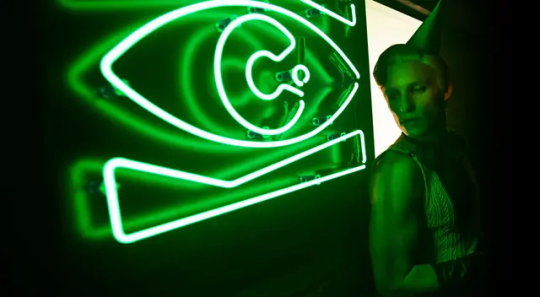
As director Rebecca Frecknall was rehearsing a new cast for her hit London revival of Cabaret, the actor playing Clifford Bradshaw, an American writer living in Berlin during the final days of the Weimar Republic, came onstage carrying that day’s newspaper as a prop. It happened to be Metro, the free London tabloid commuters read on their way to work. The date was February 25, 2022. When the actor said his line—“We’ve got to leave Berlin—as soon as possible. Tomorrow!”—Frecknall was caught short. She noticed the paper’s headline: “Russia Invades Ukraine.”
Cabaret, the groundbreaking 1966 Broadway musical that tackles fascism, antisemitism, abortion, World War II, and the events leading up to the Holocaust, had certainly captured the times once again.
Back in rehearsals four months later, Frecknall and the cast got word that the Supreme Court had overturned Roe v. Wade. Every time she checks up on Cabaret, “it feels like something else has happened in the world,” she told me over coffee in London in September.
A month later, as Frecknall was preparing her production of Cabaret for its Broadway premiere, something else did happen: On October 7, Hamas terrorists infiltrated Israel, killing at least 1,200 people and taking more than 240 hostages.
The revival of Cabaret—starring Eddie Redmayne as the creepy yet seductive Emcee; Gayle Rankin as the gin-swilling nightclub singer Sally Bowles; and Bebe Neuwirth as Fraulein Schneider, a landlady struggling to scrape by—opens April 21 at Manhattan’s August Wilson Theatre. It will do so in the shadow of a pogrom not seen since the Einsatzgruppen slaughtered thousands of Jews in Eastern Europe and in the shadow of a war between Israel and Hamas that continues into its fifth month, with the killing of thousands of civilians in Gaza.
Nearly 60 years after its debut, Cabaret still stings. That is its brilliance. And its tragedy.
Redmayne has been haunted by Cabaret ever since he played the Emcee in prep school. “I was staggered by the character,” he says. “The lack of definition of it, the enigma of it.” He played the part again during his first year at Cambridge at the Edinburgh Fringe Festival, where nearly 3,500 shoestring productions jostle for attention each summer. Cabaret, performed in a tiny venue that “stank,” Redmayne recalls, did well enough that the producers added an extra show. He was leering at the Kit Kat Club girls from 8 p.m. till 10 p.m. and then from 11 p.m. till two in the morning. “You’d wake up at midday. You barely see sunshine. I just became this gaunt, skeletal figure.” His parents came to see him and said, “You need vitamin D!”
In 2021, Redmayne, by then an Oscar winner for The Theory of Everything and a Tony winner for Red, was playing the Emcee again, this time in Frecknall’s West End production. His dressing room on opening night was full of flowers. There was one bouquet with a card he did not have a chance to open until intermission. It was from Joel Grey, who originated the role on Broadway and won an Oscar for his performance alongside Liza Minnelli in the 1972 movie. He welcomed the young actor “to the family,” Redmayne says. “It was an extraordinary moment for me.”
Cabaret is based on Goodbye to Berlin, the British writer Christopher Isherwood’s collection of stories and character studies set in Weimar Germany as the Nazis are clawing their way to power. Isherwood, who went to Berlin for one reason—“boys,” he wrote in his memoir Christopher and His Kind—lived in a dingy boarding house amid an array of sleazy lodgers who inspired his characters. But aside from a fleeting mention of a host at a seedy nightclub, there is no emcee in his vignettes. Nor is there an emcee in I Am a Camera, John Van Druten’s hit 1951 Broadway play adapted from Isherwood’s story “Sally Bowles” from Goodbye to Berlin.
The character, one of the most famous in Broadway history, was created by Harold Prince, who produced and directed the original Cabaret. “People write about Cabaret all the time,” says John Kander, who composed the show’s music and is, at 96, the last living member of that creative team. “They write about Liza. They write about Joel, and sometimes about us [Kander and lyricist Fred Ebb]. None of that really matters. It’s all Hal. Everything about this piece, even the variations that happen in different versions of it, is all because of Hal.”
In 1964, Prince produced his biggest hit: Fiddler on the Roof. In the final scene, Tevye and his family, having survived a pogrom, leave for America. There is sadness but also hope. And what of the Jews who did not leave? Cabaret would provide the tragic answer.
But Prince was after something else. Without hitting the audience over the head, he wanted to create a musical that echoed what was happening in America: young men being sent to their deaths in Vietnam; racists such as Alabama politician “Bull” Connor siccing attack dogs on civil rights marchers. In rehearsals, Prince put up Will Counts’s iconic photograph of a white student screaming at a Black student during the Little Rock crisis of 1957. “That’s our show,” he told the cast.
A bold idea he had early on was to juxtapose the lives of Isherwood’s lodgers with one of the tawdry nightclubs Isherwood had frequented. In 1951, while stationed as a soldier in Stuttgart, Germany, Prince himself had hung around such a place. Presiding over the third-rate acts was a master of ceremonies in white makeup and of indeterminate sexuality. He “unnerved me,” Prince once told me. “But I never forgot him.”
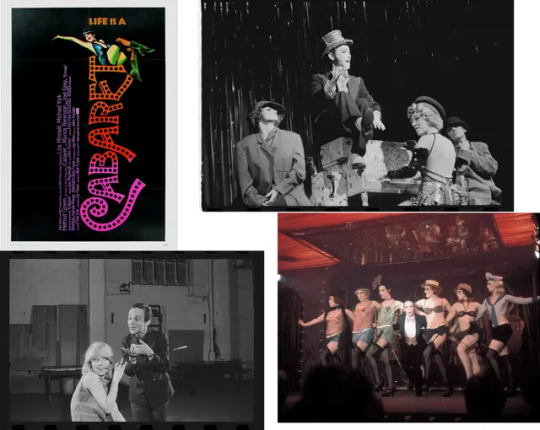
Kander had seen the same kind of character at the opening of a Marlene Dietrich concert in Europe. “An overpainted little man waddled out and said, ‘Willkommen, bienvenue, welcome,’ ” Kander recalls.
The first song Kander and Ebb wrote for the show was called “Willkommen.” They wrote 60 more songs. “Some of them were outrageous,” Kander says. “We wrote some antisemitic songs”—of which there were many in Weimar cabarets—“ ‘Good neighbor Cohen, loaned you a loan.’ We didn’t get very far with that one.”
They did write one song about antisemitism: “If You Could See Her (The Gorilla Song),” in which the Emcee dances with his lover, a gorilla in a pink tutu. At the end of the number, he turns to the audience and whispers: “If you could see her through my eyes, she wouldn’t look Jewishhh at all.” It was, they thought, the most powerful song in the score.
The working title of their musical was Welcome to Berlin. But then a woman who sold blocks of tickets to theater parties told Prince that her Jewish clients would not buy a show with “Berlin” in the title. Strolling along the beach one day, Joe Masteroff, who was writing the musical’s book, thought of two recent hits, Carnival and Camelot. Both started with a C and had three syllables. Why not call the show Cabaret?
To play the Emcee, Prince tapped his friend Joel Grey. A nightclub headliner, Grey could not break into Broadway. “The theater was very high-minded,” he once said. When Prince called him, he was playing a pirate in a third-rate musical in New York’s Jones Beach. “Hal knew I was dying,” Grey recounts over lunch in the West Village, where he lives. “I wanted to quit the business.”
At first, he struggled to create the Emcee, who did not interact with the other characters. He had numbers but “no words, no lines, no role,” Grey wrote in his memoir, Master of Ceremonies. A polished performer, he had no trouble with the songs, the dances, the antics. “But something was missing,” he says. Then he remembered a cheap comedian he’d once seen in St. Louis. The comic had told lecherous jokes, gay jokes, sexist jokes—anything to get a laugh. One day in rehearsal, Grey did everything the comedian had done “to get the audience crazy. I was all over the girls, squeezing their breasts, touching their bottoms. They were furious. I was horrible. When it was over I thought, This is the end of my career.” He disappeared backstage and cried. “And then from out of the darkness came Mr. Prince,” Grey says. “He put his hand on my shoulder and said, ‘Joely, that’s it.’ ”
Cabaret played its first performance at the Shubert Theatre in Boston in the fall of 1966. Grey stopped the show with the opening number, “Willkommen.” “The audience wouldn’t stop applauding,” Grey recalls. “I turned to the stage manager and said, ‘Should I get changed for the next scene?’ ”
The musical ran long—it was in three acts—but it got a prolonged standing ovation. As the curtain came down, Richard Seff, an agent who represented Kander and Ebb, ran into Ebb in the aisle. “It’s wonderful,” Seff said. “You’ll fix the obvious flaws.” In the middle of the night, Seff’s phone rang. It was Ebb. “You hated it!” the songwriter screamed. “You are of no help at all!”
Ebb was reeling because he’d learned Prince was going to cut the show down to two acts. Ebb collapsed in his hotel bed, Kander holding one hand, Grey the other. “You’re not dying, Fred,” Kander told him. “Hal has not wrecked our show.”
Cabaret came roaring into New York, fueled by tremendous word of mouth. But there was a problem. Some Jewish groups were furious about “If You Could See Her.” How could you equate a gorilla with a Jew? they wanted to know, missing the point entirely. They threatened to boycott the show. Prince, his eye on ticket sales, told Ebb to change the line “She wouldn’t look Jewish at all” to something less offensive: “She isn’t a meeskite at all,” using the Yiddish word for a homely person.
It is difficult to imagine the impact Cabaret had on audiences in 1966. World War II had ended only 21 years before. Many New York theatergoers had fled Europe or fought the Nazis. There were Holocaust survivors in the audience; there were people whose relatives had died in the gas chambers. Grey knew the show’s power. Some nights, dancing with the gorilla, he’d whisper “Jewish” instead of “meeskite.” The audience gasped.

Cabaret won eight Tony Awards in 1967, catapulted Grey to Broadway stardom, and ran for three years. Seff sold the movie rights for $1.5 million, a record at the time. Prince, about to begin rehearsals for Stephen Sondheim’s Company, was unavailable to direct the movie, scheduled for a 1972 release. So the producers hired the director and choreographer Bob Fosse, who needed the job because his previous movie, Sweet Charity, had been a bust.
Fosse, who saw Prince as a rival, stamped out much of what Prince had done, including Joel Grey. He wanted Ruth Gordon to play the Emcee. But Grey was a sensation, and the studio wanted him. “It’s either me or Joel,” Fosse said. When the studio opted for Grey, Fosse backed down. But he resented Grey, and relations between them were icy.
A 26-year-old Liza Minnelli, on the way to stardom herself, was cast as Sally Bowles. The handsome Michael York would play the Cliff character, whose name in the movie was changed to Brian Roberts. And supermodel Marisa Berenson (who at the time seemed to be on the cover of Vogue every other month) got the role of a Jewish department store heiress, a character Fosse took from Isherwood’s short story “The Landauers.”
Cabaret was shot on location in Munich and Berlin. “The atmosphere was extremely heavy,” Berenson recalls. “There was the whole Nazi period, and I felt very much the Berlin Wall, that darkness, that fear, all that repression.” She adored Fosse, but he kept her off balance (she was playing a young woman traumatized by what was happening around her) by whispering “obscene things in my ear. He was shaking me up.”
Minnelli, costumed by Halston for the film, found Fosse “brilliant” and “incredibly intense,” she tells Vanity Fair in a rare interview. “He used every part of me, including my scoliosis. One of my great lessons in working with Fosse was never to think that whatever he was asking couldn’t be done. If he said do it, you had to figure out how to do it. You didn’t think about how much it hurt. You just made it happen.”
Back in New York, Fosse arranged a private screening of Cabaret for Kander and Ebb. When it was over, they said nothing. “We really hated it,” Kander admits. Then they went to the opening at the Ziegfeld Theatre in New York. The audience loved it. “We realized it was a masterpiece,” Kander says, laughing. “It just wasn’t our show.”
“PAPA WAS EVEN MORE EXCITED ABOUT THE OSCAR THAN I WAS,” SAYS LIZA MINNELLI. “AND, BABY, I WAS—NO, I AM STILL—EXCITED.”
The success of the movie—with its eight Academy Awards—soon overshadowed the musical. When people thought of Cabaret, they thought of finger snaps and bowler hats. They thought of Fosse and, of course, Minnelli, who would adopt the lyric “Life is a cabaret” as her signature. Her best-actress Oscar became part of a dynasty: Her mother, Judy Garland, and father, director Vincente Minnelli, each had one of their own. “Papa was even more excited about the Oscar than I was,” she says. “And, baby, I was—no, I am still—excited.”
By 1987—in part to burnish Cabaret’s theatrical legacy—Prince decided to recreate his original production on Broadway, with Grey once again serving as the Emcee. But it had the odor of mothballs. The New York Times drama critic Frank Rich wrote that it was not, as Sally Bowles sings, “perfectly marvelous,” but “it does approach the perfectly mediocre.” Much of the show, he added, was “old-fashioned and plodding.”
In the early 1990s, Sam Mendes, then a young director running a pocket-size theater in London called the Donmar Warehouse, heard the novelist Martin Amis give a talk. Amis was writing Time’s Arrow, about a German doctor who works in a concentration camp. “I’ve already written about the Nazis and people say to me, ‘Why are you doing it again?’ ” Amis said. “And I say, what else is there?”
At the end of the day,” Mendes tells me, “the biggest question of the 20th century is, ‘How could this have happened?’ ” Mendes decided to stage Cabaret at the Donmar in 1993. Another horror was unfolding at the time: Serb paramilitaries were slaughtering Bosnian Muslims, “ethnic cleansing” on an unimaginable scale.
Mendes hit on a terrific concept for his production: He transformed his theater into a nightclub. The audience sat at little tables with red lamps. And the performers were truly seedy. He told the actors playing the Kit Kat Club girls not to shave their armpits or their legs. “Unshaved armpits—it sent shock waves around the theater,” he recalls. Since there was no room—or money—for an orchestra, the actors played the instruments. Some of them could hit the right notes.
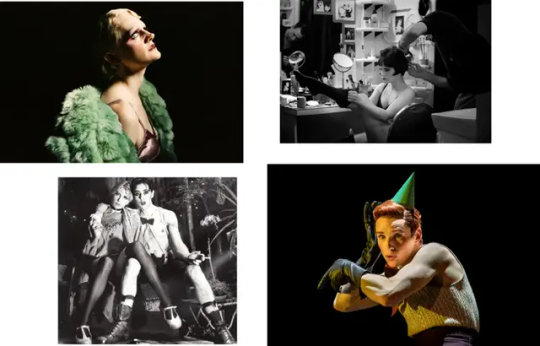
To play the Emcee, Mendes cast Alan Cumming, a young Scottish actor whose comedy act Mendes had enjoyed. “Can you sing?” Mendes asked him. “Yeah,” Cumming said. Mendes threw ideas at him and “he was open to everything.” Just before the first preview, Mendes suggested he come out during the intermission and chat up the audience, maybe dance with a woman. Mendes, frantic before the preview, never got around to giving Cumming any more direction than that. No matter. Cumming sauntered onstage as people were settling back at their tables, picked a man out of the crowd, and started dancing with him. “Watch your hands,” he said. “I lead.”
Cumming’s Emcee was impish, fun, gleefully licentious. The audience loved him. “I have never had less to do with a great performance in one of my shows than I had to do with Alan,” Mendes says.
When Joe Masteroff came to see the show in London, Mendes was nervous. He’d taken plenty of liberties with the script. Cliff, the narrator, was now openly gay. (One night, when Cliff kissed a male lover, a man in the audience shouted, “Rubbish!”) And he made the Emcee a victim of the Nazis. In the final scene, Cumming, in a concentration camp uniform affixed with a yellow Star of David and a pink triangle, is jolted, as if he’s thrown himself onto the electrified fence at Birkenau.
“I should be really pissed with you,” Masteroff told Mendes after the show. “But it works.” Kander liked it too, though he was not happy that the actors didn’t play his score all that well. Ebb hated it. “He wanted more professionalism,” Mendes says. “And he was not wrong. There was a dangerous edge of amateurishness about it.”
The Roundabout Theatre Company brought Cabaret to New York in 1998. Rob Marshall, who would go on to direct the movie Chicago, helped Mendes give the show some Broadway gloss while retaining its grittiness. The two young directors were “challenging each other, pushing each other,” Marshall remembers, “to create something unique.”
Cumming reprised his role as the Emcee. He was on fire. Natasha Richardson, the daughter of Vanessa Redgrave and director Tony Richardson, played Sally Bowles. She was not on fire. She’d never been in a musical before, and when she sang, “There was absolutely no sound coming out,” Kander says.
“She beat herself up about her singing all the time,” Mendes adds. “There was a deep, self-critical aspect of Tash that was instilled by her dad, a brilliant man but extremely cutting.” He once said to her out of nowhere: “We’re going to have to do something about your chin, dear.” As Mendes saw it, she always felt that she could never measure up to her parents.
Kander went to work with her, and slowly a voice emerged. It was not a “polished sound,” Marshall says, but it was haunting, vulnerable. Still, Cumming was walking away with the show. At the first preview, when he took his bow, the audience roared. When Richardson took hers, they were polite. Mendes remembers going backstage and finding her “in tears.” But she persevered and through sheer force of will created a Sally Bowles that “will break your heart,” Masteroff told me the day before I saw that production in the spring of 1998. She did indeed. (Eleven years later, while learning how to ski on a bunny hill on Mont Tremblant, she fell down. She died of a head injury two days later.)
The revival of Cabaret won four Tony Awards, including one for Richardson as best actress in a musical. It ran nearly 2,400 performances at the Roundabout’s Studio 54 and was revived again in 2014. And the money, money, money, as the song goes, poured in. Once Masteroff, having already filed his taxes at the end of a lucrative Cabaret year, went to the mailbox and opened a royalty check for $60,000. “What the hell am I supposed to do with this?” he snapped.
Rebecca Frecknall grew up on Mendes’s Donmar Warehouse production of Cabaret. The BBC filmed it, and when it aired, her father videotaped it. She watched it “religiously.” But when she came to direct her production, she had to put Mendes’s version out of her mind.
Mendes turned his little theater into a nightclub. Frecknall, working with the brilliant set and costume designer Tom Scutt, has upped the game. They have transformed the entire theater into a Weimar cabaret. You stand in line at the stage door, waiting, you hope, to be let in. Once inside, you’re served drinks while the Kit Kat Club girls dance and flirt with you. The show’s logo is a geometric eye. Scutt sprinkles the motif throughout his sets and costumes. “It’s all part of the voyeurism,” Scutt explains. “The sense of always being watched, always watching—responsibility, culpability, implication, blame.”
REDMAYNE’S EMCEE IS STILL SEXY AND SEDUCTIVE, BUT AS THE SHOW GOES ON HE BECOMES A PUPPET MASTER MANIPULATING THE OTHER CHARACTERS, SOMETIMES TO THEIR DOOM.
Mendes’s Cabaret, like Fosse’s, had a black-and-white aesthetic—black fishnet stockings, black leather coats, a white face for the Emcee. Frecknall and Scutt begin their show with bright colors, which slowly fade to gray as the walls close in on the characters. “Color and individuality—to grayness and homogeneity,” Frecknall says.
As the first woman to direct a major production of Cabaret, Frecknall has focused attention on the Kit Kat Club girls—Rosie, Fritzie, Frenchie, Lulu, and Texas. “Often what I’ve seen in other productions is this homogenized group of pretty, white, skinny girls in their underwear,” she insists. Her Kit Kat Club girls are multiethnic. Some are transgender. Through performances and costumes, they are no longer appendages of the Emcee but vivid characters in their own right.

Her boldest stroke has been to reinvent the Emcee. She and Redmayne have turned him into a force of malevolence. He is still sexy and seductive, but as the show goes on, he becomes a skeletal puppet master manipulating the other characters to, in many cases, their doom. If Cumming’s Emcee was, in the end, a Holocaust victim, Redmayne’s is, in Frecknall’s words, “a perpetrator.”
Unwrapping a grilled cheese sandwich in his enormous Upper West Side townhouse, Kander says that his husband had recently asked him a pointed question: “Did it ever occur to you that all of you guys who created Cabaret were Jewish?”
“Not really,” Kander replied. “We were just trying to put on a show.” Or, as Masteroff once said: “It was a job.”
It’s a “job” that has endured. The producers of the Broadway revival certainly have faith in the show’s staying power. They’ve spent $25 million on the production, a big chunk of it going to reconfigure the August Wilson Theatre into the Kit Kat Club. Audience members will enter through an alleyway, be given a glass of schnapps, and can then enjoy a preshow drink at a variety of lounges designed by Scutt: The Pineapple Room, Red Bar, Green Bar, and Vault Bar. The show will be performed in the round, tables and chairs ringing the stage. And they’ll be able to enjoy a bottle (or two) of top-flight Champagne throughout the performance.
This revival is certainly the most lavish Cabaret in a long time. But there have been hundreds of other, less heralded productions over the years, with more on the way. A few months before Russia invaded Ukraine, Cabaret was running in Moscow. Last December, Concord Theatricals, which licenses the show, authorized a production at the Molodyy Theatre in Kyiv. And a request is in for a production in Israel, the first since the show was produced in Tel Aviv in 2014.
“The interesting thing about the piece is that it seems to change with the times,” Kander says. “Nothing about it seems to be written in stone except its narrative and its implications.”
And whenever someone tells him the show is more relevant than ever, Kander shakes his head and says, “I know. And isn’t that awful?”′
You can also listen the entire article here !!
https://www.vanityfair.com/style/cabaret-revival
I know it's a very long article , but very interesting!!
#eddie redmayne#cabaret#cabaret story#theatre#vanity fair#liza minelli#alan cumming#rebecca frecknall#director#gayle rankin#sally bowles#the emcee#nyc#august wilson#broadway#tom scutt#costume designer#scenic theatre#emma stone
20 notes
·
View notes
Text






New video ft. cast interviews and footage from rehearsals and the show - Cabaret on CBS Sunday morning.
youtube
#eddie redmayne#redmayne#emcee#cabaret#cabaret at the kit kat club#cabaretnyc#cabaret 2024#broadway#august wilson theatre#gayle rankin#bebe neuwirth#tom scutt#Youtube#rebecca frecknall#cabaretinterview#cabaretpromo#cbs sunday morning
17 notes
·
View notes
Text
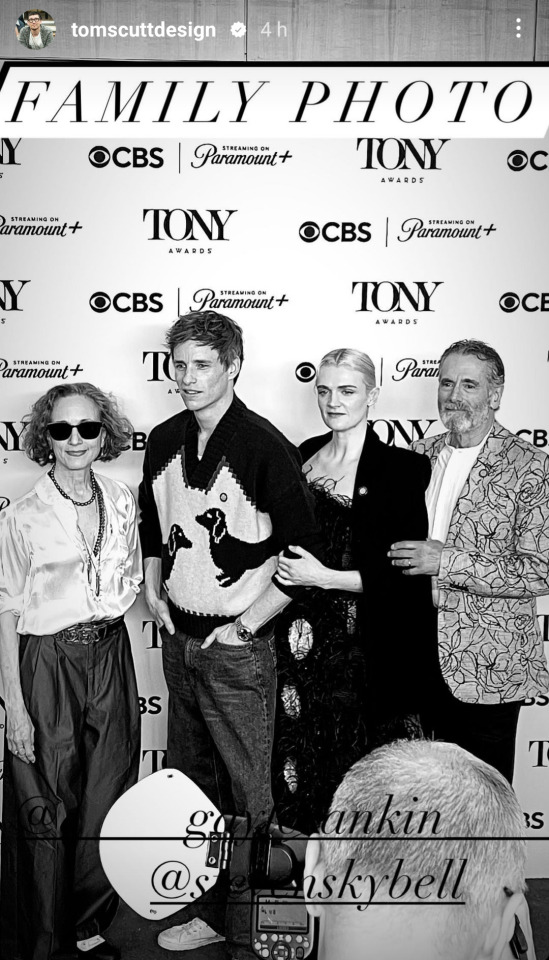
"Cabaret Family" at the 2024 Tony Award Nominee event, today!
📷 From Tom Scutt IG Stories.
#eddie redmayne#eddieredmayne#redmayne#cabaret 2024#cabaret nyc#gayle rankin#bebe neuwirth#tom scutt#steven skybell
11 notes
·
View notes
Text
Broadway-bound

As rehearsals launch this week for Cabaret at the Kit Kat Club on Broadway, we recall the first glimpse we received of Eddie Redmayne’s shape-shifting Emcee rehearsing “Money” with a brilliant ensemble just before the London opening in Nov. 2021…+ his final look in the number’s iconic costume by Tom Scutt.
📸: Marc Brenner 🎥: Spotify Cabaret London cast recording

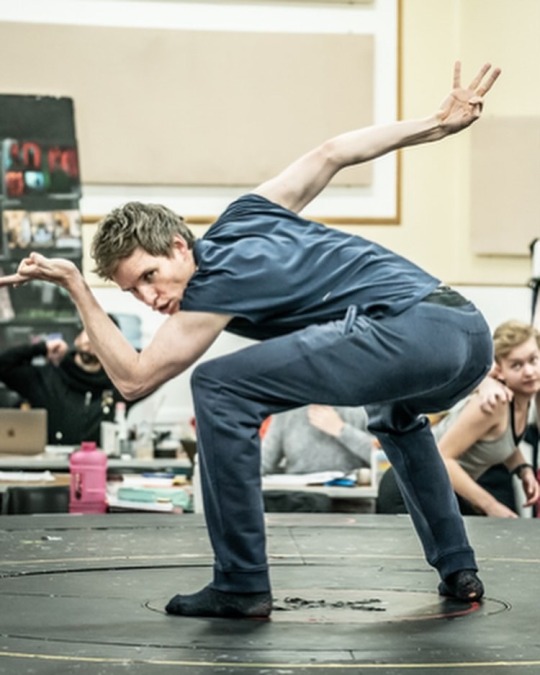
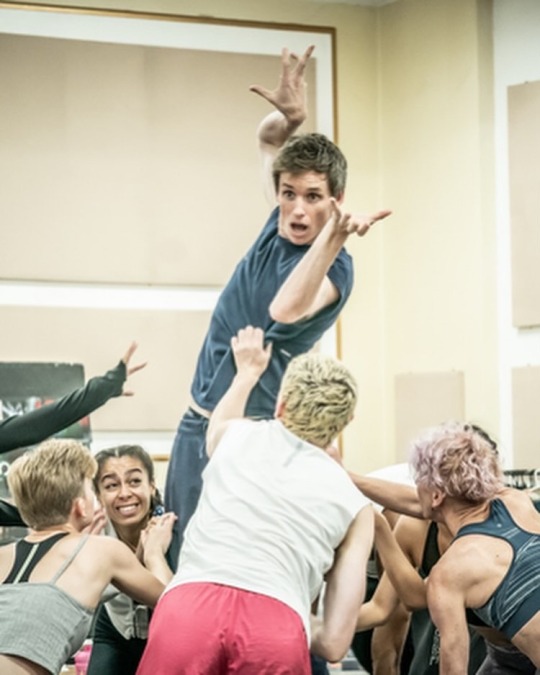



#eddie redmayne#Cabaret at the Kit Kat Club NYC#Cabaret at the Kit Kat Club London#Tom Scutt#ATG#marc brenner
8 notes
·
View notes
Text
I can't stop thinking about the dreamworld version of love comes quickly. they always do that song soooo right
#rewatched their glastonbury performance. its probably my fav bit besides the encore. JUST THE VISUALS#the way neil walks slowly across the stage. the inevitability. the atmospheric version of the instrumentation#the paninaro sample right at the end#im sorry i can't stop thinking about it#tom scutt i am amazed#pet shop boys
8 notes
·
View notes
Note
Bestie, please break down those costumes.Plssss.I am soooooo jealous of U🫀❤️♥️
of course!
the 2018 regent's park open air theatre little shop of horrors production is pretty standout visually because (while they didn't change the script by updating it) they did move away from the typical 1960s historical fashion for the characters and instead played with modern outfits and a blend of textures. the whole show had a strong colour scheme of black and white, neon green, pink, and blue. costumes & scenic design was by tom scutt.
we'll start with seymour, as played by the lovely marc antolin. his outfit is all blue, down to his glasses. (why are the curtains blue? you could say for his boyishness, or that he's kind of a melancholy character, or that white guys always wear blue, take your pick haha)
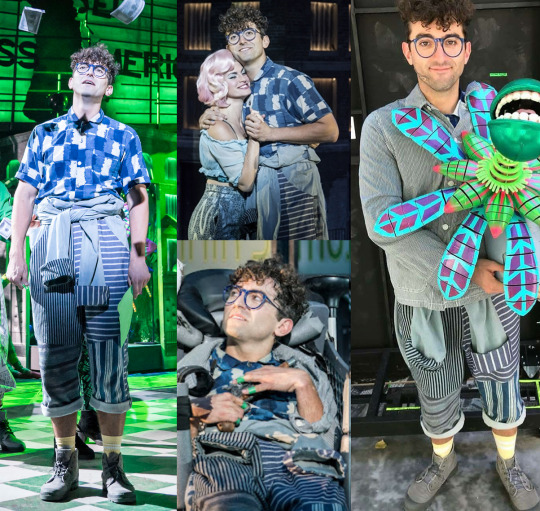
the main bit is a boiler suit made of different patchworked denim in various contrasting stripes and tied around his waist. his short sleeve button up continues the patchwork vibe with the painted brushstroke-esque check pattern. he also wears a shacket at certain points, and while hard to see in the above image it also had a thin pinstriped pattern. seymour is all about pattern mixing. a fun detail to note is that audrey ii's main colour is obviously green: in the centre bottom photo you can see he wore green band-aids on his fingers :')
also: while in these above photocall pictures that were used in promotion here had him in yellow socks, it's important to note that, at least when i saw it, his socks were pink. who's main colour is pink? it's audrey.
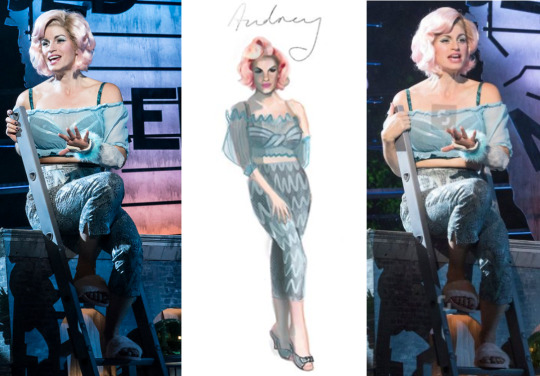
actually, her first outfit is also mostly blue. seymour and audrey have the most similar colour scheme so that gives them a strong visual link. so her first outfit is very much giving sexy: she's got a frilly top that we can see her bra through. we have a nod to vintage fashion with her cigarette pants. also while these photos show her wearing fluffy slide slippers, when i saw it she was wearing the little clear plastic kitten heels shown in the design sketch - we can tell this is her 'im trying to look sexually appealing to my boyfriend' look. she's showing it all off.
but notably, her hair is this adorable bubblegum pink shade, so i thought it was extra cute that seymour had socks to match. just a little hint of who he's thinking about.
anyway, during act 2, when audrey & seymour's relationship is blossoming further, audrey debuts a different look entirely:
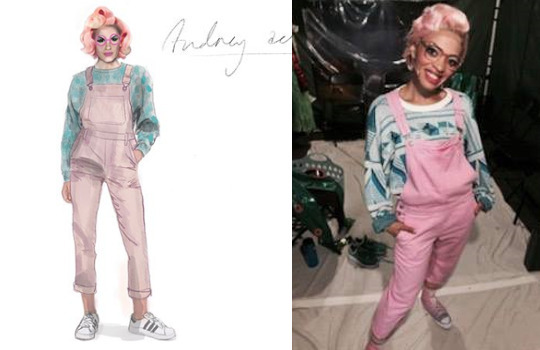
(concept sketch shown along with a photo of understudy rosalind james.) in dramatic constrast to her 'sexy-for-orin' look, now she's in dungarees and a cute sweater, and she's swapped the heels out for sneakers. also, she's got on a pair of pink glasses, suggesting that contact lenses were part of her sexy look. this look is all about comfort: because she's happy and in love with seymour, who makes her feel more comfortable than orin did, and this outfit looks nicely like the 'partner' look to seymour's outfit.
this is getting long, so the rest is going under a readmore. click through!
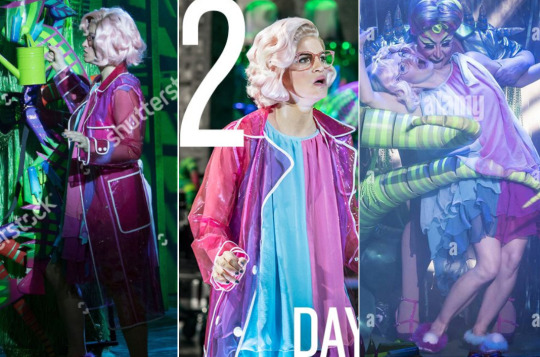
so this is her 'sominex' outfit, the look she wears when she encounters audrey ii just before she dies. the clear raincoat is honestly just fun. i think if i recall right the stage directions in the script do call for her to be wearing a yellow rain-slicker, but pink is this audrey's colour, so she's rocking this. the glasses are still on too.
underneath, she's wearing this fun floaty half-blue half-pink nightie with matching 'mismatched' pompom slippers. she is giving everything in this look honestly. the meeting of the pink-and-blue, because she's wearing both her own and seymour's main colours (she'd still love him, even if he'd never found the plant, and all she wanted was to be with seymour 😭)
i'll do orin next:

absolutely obsessed with matt willis as the dentist. as a busted fan in my childhood, i went to see this production specifically for him :') so he's got a much more dishevelled punk look he's very ghoulish with his white foundation and heavy black eyeliner. also love the detail of him having a blacked-out tooth too, really emphasises how he's probably not the best of dentists. his dentist gear including bloody apron is in a very medical neon blue-green, and i love how utterly sci-fi horror the gas mask harness is. LOVE the ripped off sleeves on his white coat. he also had this amazing leather jacket with tooth design on and the ensemble had matching outfits:
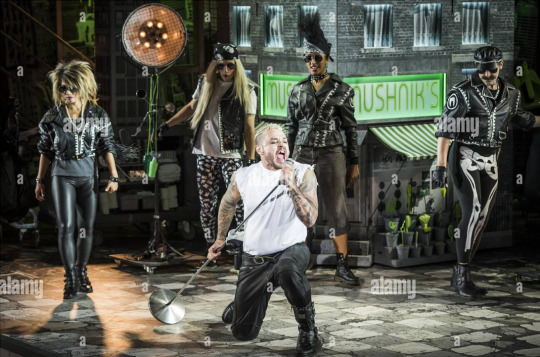
get a load of the teeth print leggings on the backup dancer on the middle left, absolutely obsessed. love the 1980s punky vibe for the 'dentist' number. this production makes great use of matt willis' own tattoos: after seymour kills orin, he came back on stage with some dismembered orin bits, and the creative team had gone to the effort of painting matt willis' tattoos onto the fake arms that seymour fed to the plant :')
okay let's move on and look at mr mushnik, played by forbes masson:
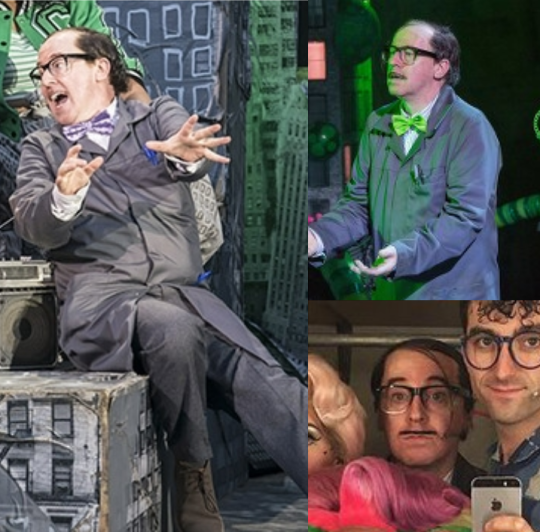
small guy, huge voice, absolute standout. they've gone for 'little greasy man' as the vibe here, complete with a drawn-on pencil moustache. his outfit, much like the ensemble, doesn't have a lot of colour, just a fairly normal grey suit with a work jacket. the most notable thing about his look is that while he starts out in a purple bow tie, once the shop starts seeing success, he wears a bow tie in audrey ii's neon green. like seymour's band-aids, audrey ii's colour (and therefore her influence/impact) shows up in the costumes of a lot of the other characters.
let's do audrey ii next then, as played by vicky vox:
so this production makes use of both the usual 'audrey ii is a puppet' situation plus then having the drag queen performer on stage to interact with the other characters as like, the plant personified. absolute LOVED it. let's start with the puppet:
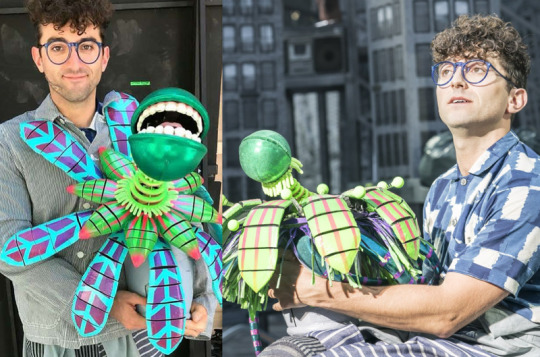
we've got the baby form and slightly bigger form i think here, it's a fun alien looking plant, love the spherical head with human teeth. for the plant to 'grow', a bigger version of this plant head is placed inside of a 'mouth' that can open and close sort of like an aperture:

and upon opening it, drag queen audrey ii steps out. she kind of comes in and out of it, and mostly just interacts with seymour.


this outfit is absolutely fabulous, and i especially love the 'HERE IT IS' pointing down to her booty on the back of the jacket.
then a notable progression for audrey ii's appearance is the changing wigs. we can see that her first wig shown here below is the direct partner of audrey's, (after all, the plant was named after her) and is styled the same way.
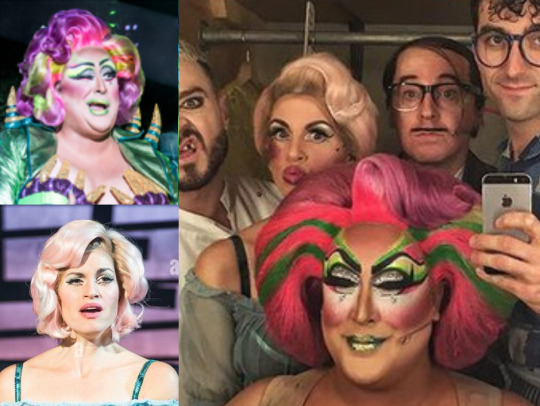
when i saw the show, both audreys were wearing different wigs that i thought weren't really as pretty as the ones from the photocall, these wigs are on the left of the above image. i'll call these the round wigs.
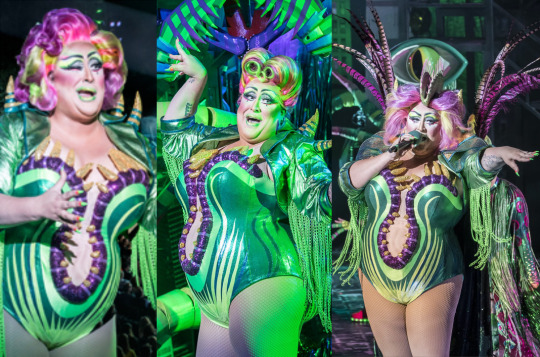
the most important thing to note though is that when audrey ii first appears, she has that strong visual link to original audrey. and this is played up in the way that audrey ii interacts with seymour during 'feed me' - audrey ii acts quite flirtatious with seymour and he seems receptive to it and has to visibly shake himself out of it. then in the second act, audrey ii switches wigs to the style in the above middle. during suppertime, there was more of audrey ii trying to be flirtatious with seymour, but at this point he is much more disgusted by it: audrey ii's wig no longer resembles original audrey’s, and by now seymour hates her guts.
the final look for audrey ii via photocall features what seems to be the original wig but with the curls blown out, styled to be more messy and windswept, but by the end of the run during the finale audrey ii just wore the round wig, with the added venus flytrap headpiece and feathered cape.
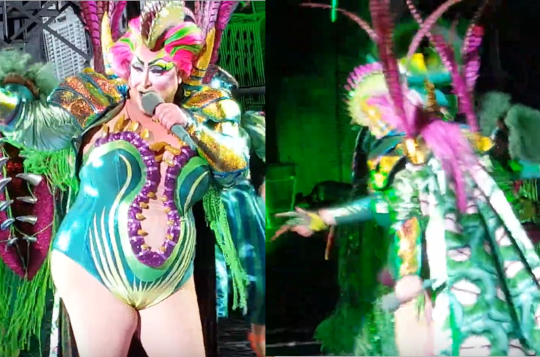
apologies for the terrible screencaps: the fabric the cape was made of featured green rocky horror-esque lips showing teeth. it was mega. the wig also featured some long pink extensions at the back.
let's go back a bit to some other characters who have been wearing audrey ii's green consistently, and that's the urchins:
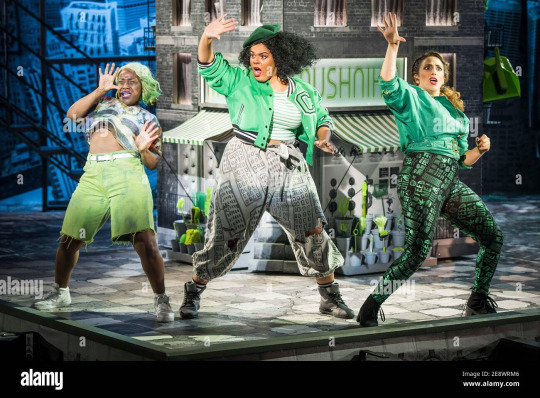
they wear these punky, i would say more 1990s streetwear inspired costumes throughout the whole show, and don't change until the end. the two gals on the left wear pieces that tie in strongly to the set, which is a crumbling grayscale newspaper-inspired city/drive-in theatre set proclaiming 'GOD BLESS AMERICA' across the top.
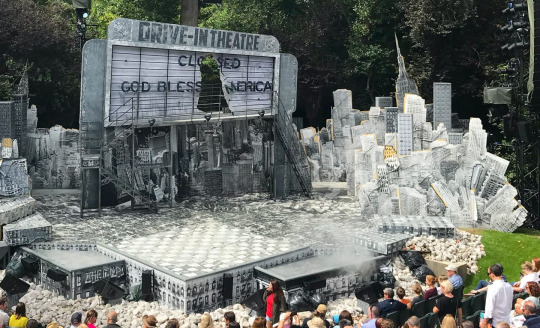
we can see the girl on the far left has a grayscale US flag top, while the middle girl has grey cityscape patterned sweatpants. then all three of them are wearing the bright neon of audrey ii, reminded us and the audience who's story they're telling. out of the 3, my definite fave look is the girl on the right, with the green jacket and shiny 'FEED ME' print leggings. i need those leggings. but yes what we can notice is that 2/3 urchins' outfits align strongly not only with audrey ii's green but with the same grayscale/cityscape patterns that the ensemble wear during skid row & other scenes:
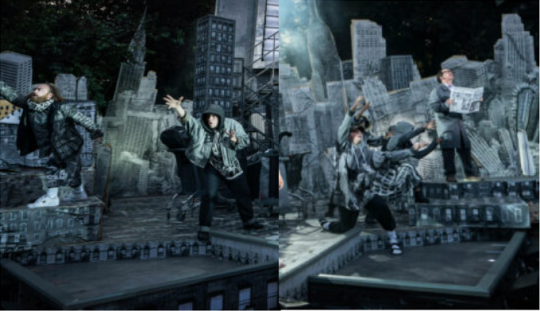
anyway i like that the ensemble's look speaks to like... the set coming alive to tell the story. it's cool. this comes back during act 2 when the ensemble put on gloves that resemble audrey ii's vines and push around shopping trolleys with bits of building set inside:
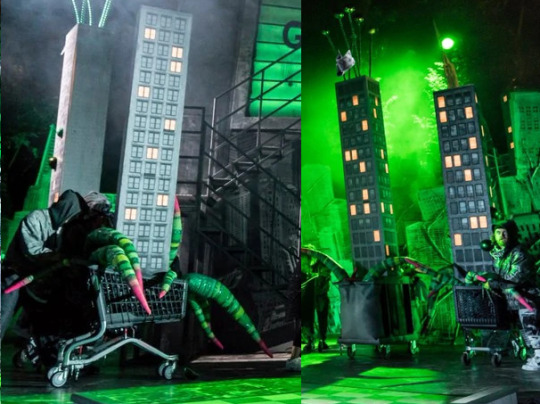
not so easy to see that they were wearing the gloves, but basically they had long fingers that looked like smaller versions of these vines.
and with all this green let's get to the finale, where everyone has a different look. we've already seen audrey ii, here's the urchins.
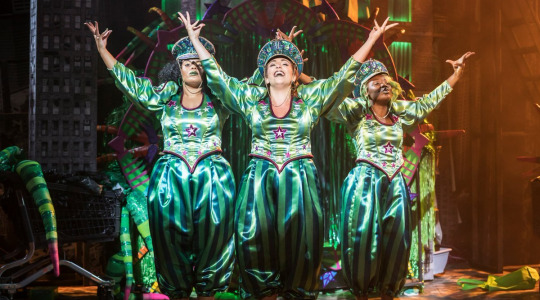
lovely and shiny looks, this time they're all wearing the same thing. these are their sort of... idk i guess this is circus vibes tbh? welcome to this absolute circus: the finale definitely DOES have a circus vibe, making clowns of the cast, particularly seymour. here's a look at everyone with audrey ii lording over everything at the top:
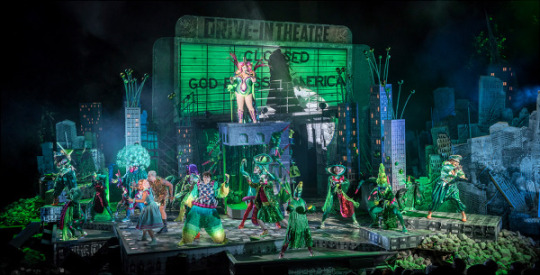

the enesmble have VERY fun alien plant costumes on, with a big focus on toothy mouths and floppy tongues (we've seen audrey ii's cape with its green lips so it's all on the same oral fixation) let's take a closer look at seymour's outfit, which is definitely giving clown, considering he was the great fool of the story.
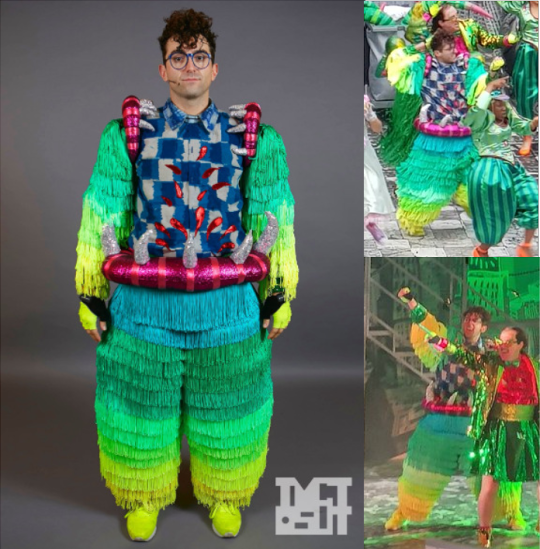
so it's this great big fluffy clown suit over his blue shirt that now his this shiny blood appliqued on, love it, with the green on the limbs ending at the shirt with the plant lips and teeth at his shoulders/waist, implying that his limbs have been eaten by the plant. this is great to see in action!
now let's take a look at the rest which i'm gonna have to show via very low quality screencaps because seymour's was the only photo tom scutt posted. here's audrey, orin & mushnik's 'plant looks', these guys are more like... audrey ii's put them in drag.

audrey's achieved her somewhere that's green fantasy, in a great swirly dress with full skirt and ruffly sleeves, still in her blue and pink colour scheme, in her same sneakers and pink glases. she's also got white lace gloves on. audrey ii said 'okay girl you can have this as a treat'. hers is the least alien-plant because it's like... audrey's fantasy look, and i love that.
orin's in a gold sequin mini-dress, but still his same combat boots. it reminds me of a brad pitt photoshoot from rolling stone 1999. look it up and i think you'll agree and i'd hazard a guess that it was a direct inspiration for this look.
mushnik's got on the long vine-finger gloves that the ensemble has during the meek shall inherit, and then a spectacular sequined set: blazer, bow tie, and the actor forbes masson said it's specifically supposed to be a kilt, because he is scottish and i think chose this as part of his look. he's also got light up gold sneakers, obsessed, and in the close up you get a look at his gold & green cats eye glasses and green lipstick.
okay i think! i've covered all of the main looks, or at least everything that i could find reasonably clear images of. iirc seymour did have a leather jacket for the scene where he's trying to make himself more like orin because he thinks audrey will like that, but i couldn't find any photos.
thanks for reading! i know this was a long post but i absolutely adoooore the visuals of this production and its a damn shame that it doesn't have a recording 😭😭😭
#little shop of horrors#regent's park open air theatre#LSOH#seymour krelborn#audrey fulquard#orin scrivello
76 notes
·
View notes
Text
'Cabaret' Revival is an Expressionistic, Hypnotic, Smashing Must-See
Run to this revival and ignore the misguided critics who missed whole swaths of director Rebecca Frechnall's vision. It' spectacular.
Eddie Redmayne and the company of Cabaret (Marc Brenner)
Rebecca Frecknall’s darkly spirited and remarkable revival of the amazing John Kander and Fred Ebb musical Cabaret, haunts as it moves with frenzy toward increasingly frightening revelations filled with understated, metaphoric violence. With book by Joe Masteroff, Julia Cheng’s choreography, and Tom Scutt’s breathtaking scenic, theater and…

View On WordPress
#Ato Blankson-wood#Bebe Neuwirth#Cabaret at the Kit Kat Club#Eddie Redmayne#Gayle Rankin#Henry Gottfried#Rebecca Frecknall#Steven Skybell
3 notes
·
View notes
Text
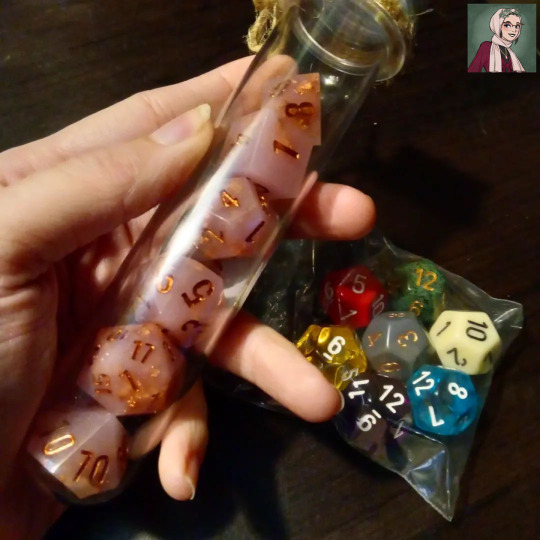
Instagram Repost: January 3, 2023
The dice gremlin has been unleashed 💜 My new dice came in today for the fun my Husband and I are about to have with 📚 'The Solo Adventurer's Ultimate Toolbox' (Paul Bimler) + 📚 'Dm Yourself' / 📚 'DM Yourselves' (Tom Scutt), and I'm SO unbelievably excited.
It's a horrid picture of them because it's late and I'm in the basement, but I got the 'Maiden's Kiss' Sharps from ticcrafts; it's surprisingly difficult to find Sharps these days (what happened!), but I'm so glad I managed to find the most precious Rose Gold and pink set- and in sharps 😭 They're so perfect for my Character.
The rest of the dice are a bunch of 6d12 we ordered from Dice Game Depot for the 6d12 system that gets outlined in The Solo Adventurer's Toolbox; nothing special- though we did color code them so we never get confused (and bought an extra one in case a Cat runs off with one; a very real threat with 4 of the demons living in this house).
1 note
·
View note
Text
Cabaret Broadway Review
If so much of it weren’t so out of balance, this fourth Broadway revival of “Cabaret” would be impressive in its complete transformation of Kander and Ebb’s great musical – physically, visually, and, in one respect, morally.
Much of the credit or blame goes to Tom Scutt, who is the costume designer, scenic designer, and theater designer of the production, which was a hot ticket in London, and…
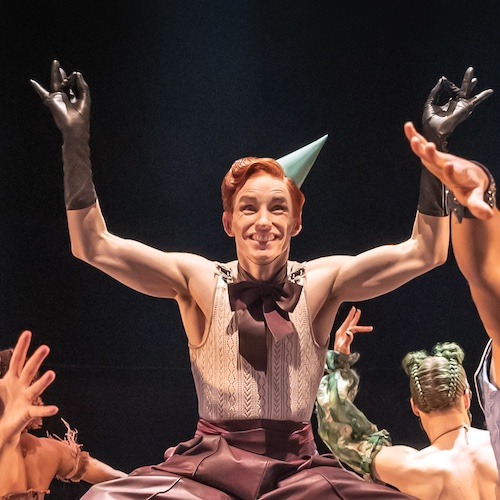
View On WordPress
0 notes
Text





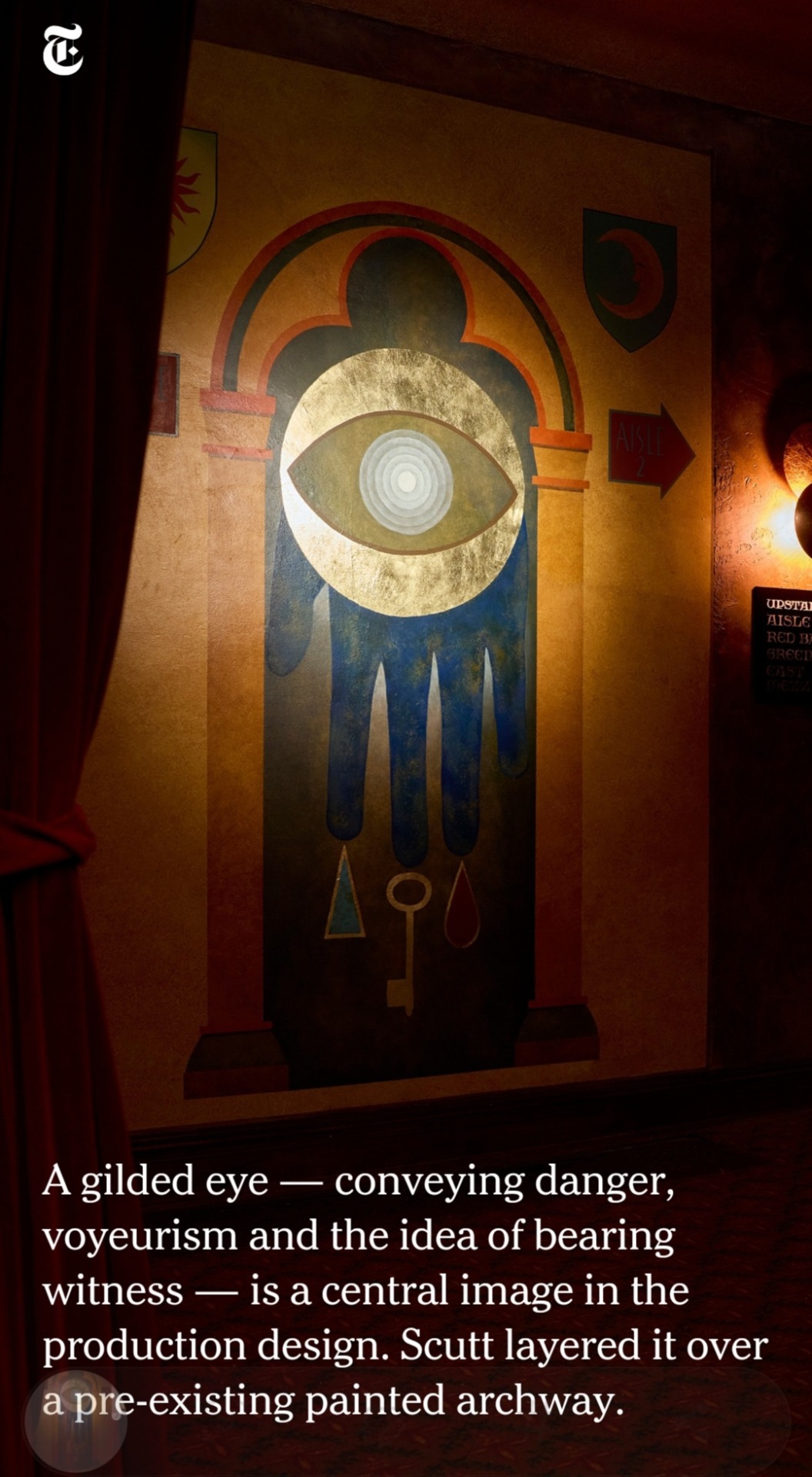


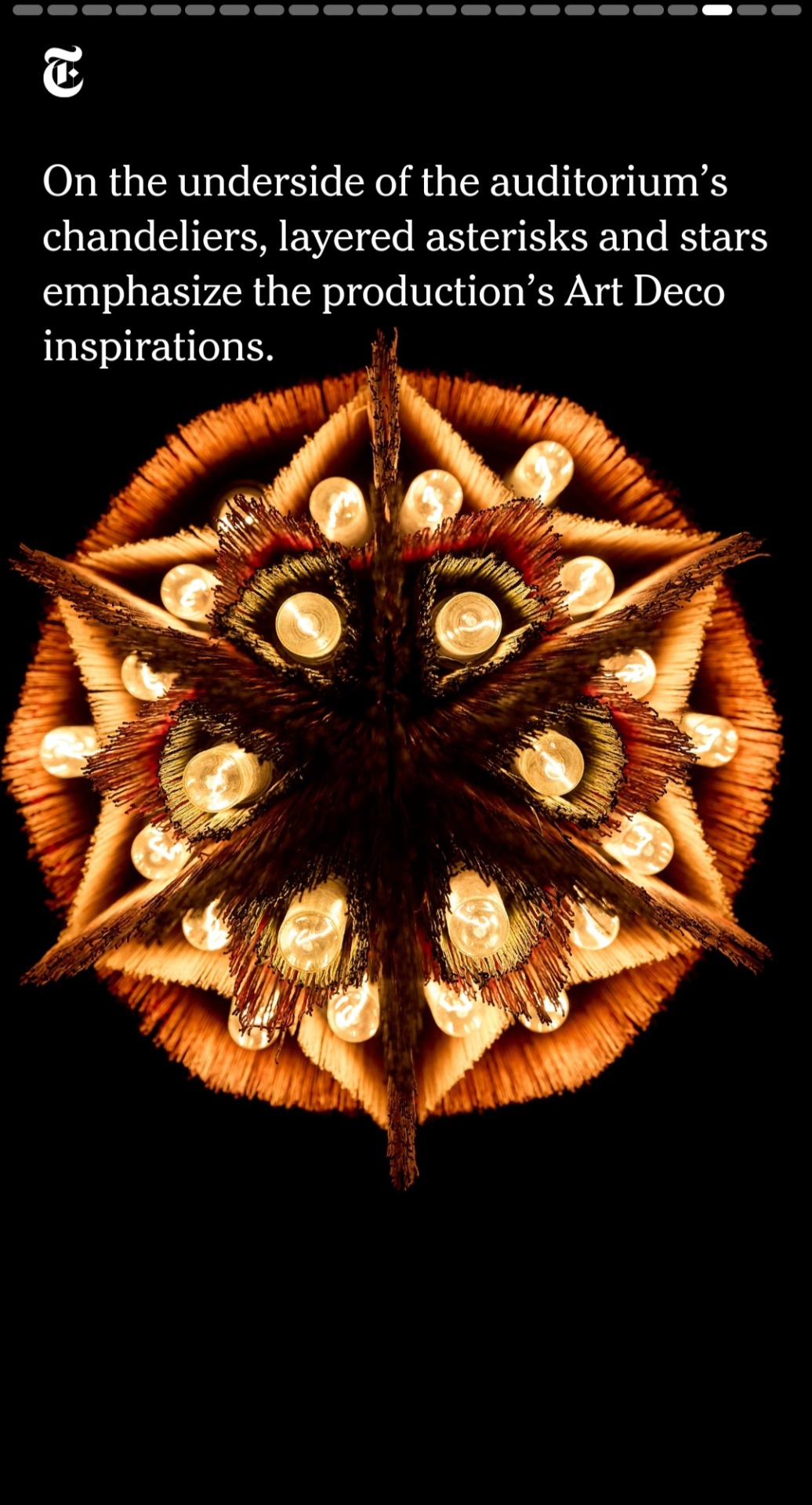

A look inside The August Wilson Theatre!!
"HOW A Broadway Theater was remade into a Queer Cabaret"
Photographer David Chow
#eddie redmayne#august wilson theatre#broadway#kit kat club#cabaret#cabaret nyc#cabaret new production#the emcee#tom scutt#designer#new york times#article#photographer#david chow
15 notes
·
View notes
Text
Today on the spring equinox our new album 'Never The Same Way Twice' makes it's way into the World. The album is a collection of previously unreleased recordings to mark twenty years since the release of our self-titled debut album. Two decades is a long time and the over-riding emotion I have for this album is one of gratitude, to those who have supported our music and everyone that has taken time to listen. In particular I am so very grateful to all the amazing musicians who have given their time and talents to make The Memory Band what is is, I am forever in their debt. There is not the space to thank everyone who has been part of the band but the people who perform on this album are as follows: John Andrews, Liam Bailey, Liza Bec, Alex Bonney, Helene Bradley, Olie Brice, Jonny Bridgwood, Findlay Brown, Dee Byrne, Hannah Caughlin, Olivia Chaney, Howard Cottle, Al Doyle, Sam Genders, Adem Ilhan, Lisa Knapp, Jennymay Logan, Simon Lord, Paul McGee, Rhys Morgan, Tom Page, Polly Paulusma, Jeremy Radway, Lucy Railton, Jess Roberts, Quinta, Sarah Scutt, Rob Spriggs, Serafina Steer, Alexis Taylor, Fred Thomas, Jon Thorne and Nancy Wallace. You are all marvellous March hares.
Stephen Cracknell. 20.03.2004
1 note
·
View note
Text
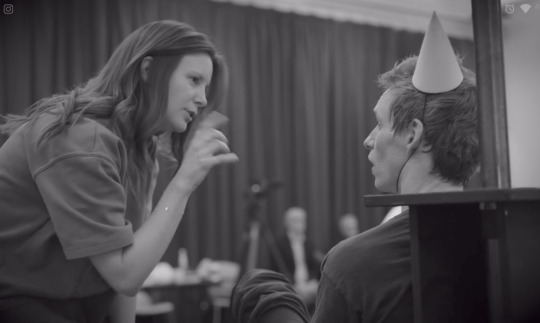
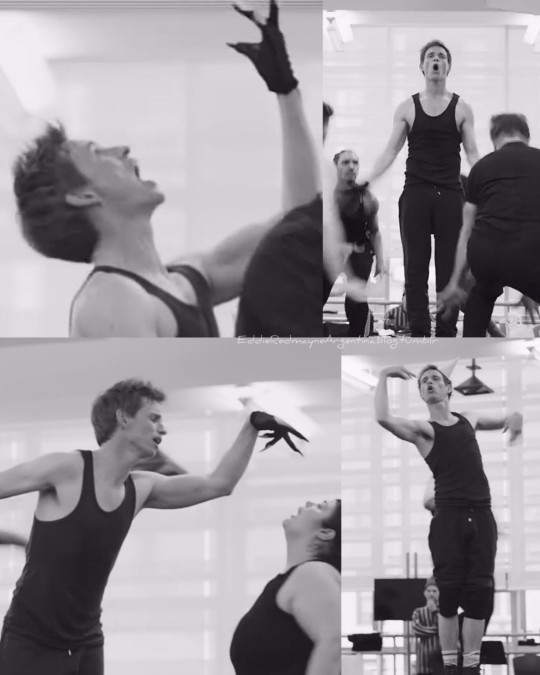
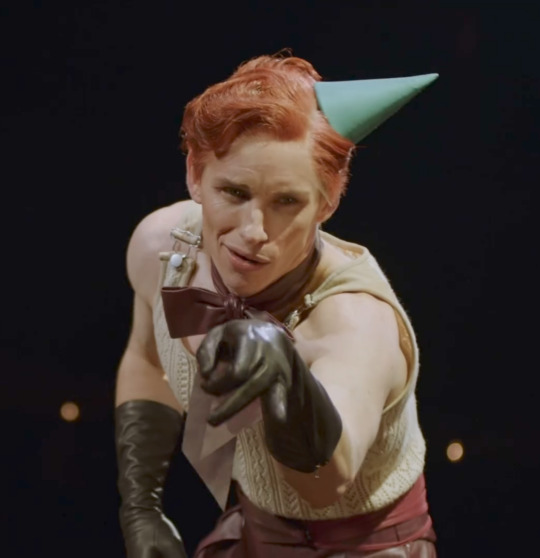
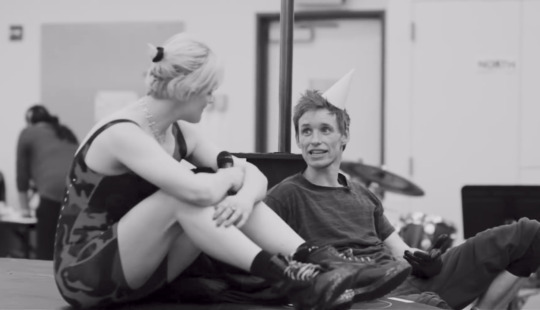
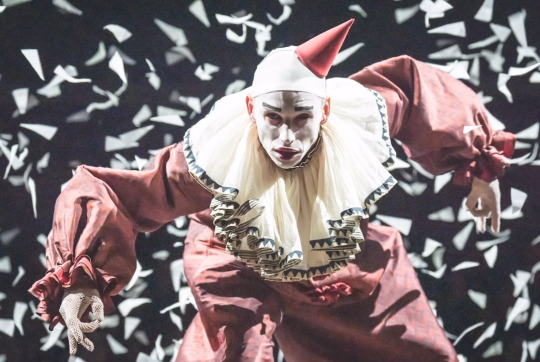


Cabaret at the kit kat Club on Broadway.
📷 My screenshots from Cabaret at the kit kat Club NYC's Videos. 1 - 2
#eddie redmayne#eddieredmayne#redmayne#cabaret 2024#cabaret nyc#gayle rankin#rebecca frecknall#tom scutt
12 notes
·
View notes
Text
‘Less Bob Fosse, more Stanley Kubrick…’
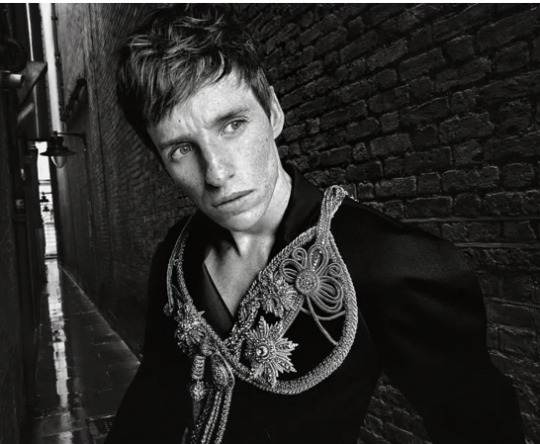
An insightful look at the Broadway-bound production of Cabaret at the Kit Kat Club from Vogue, including interviews and photos with Eddie Redmayne + Gayle Rankin and behind-the-scenes glimpses from creatives Rebecca Frecknall (director) + Tom Scutt (theater/set/costume designer) on creating the production + on its London-to-NYC journey.
[Photos: Julien Martinez Leclerc Stylist: Harry Lambert]




17 notes
·
View notes
Text
this version of love comes quickly and hearing being boring in the encore is all I want out of the unity tour they can do whatever else but as long as I hear those two songs live i'll die happy
youtube
#ESPECIALLY this version and staging of love comes quickly#like tom scutt and stuart price are you KIDDING ME#THIS IS#ohhhhh boy#im so excited like its settling in now im seeing them in a month#im going to cry so bad during the encore lmaoooo#Youtube
3 notes
·
View notes
Text
0 notes
Text
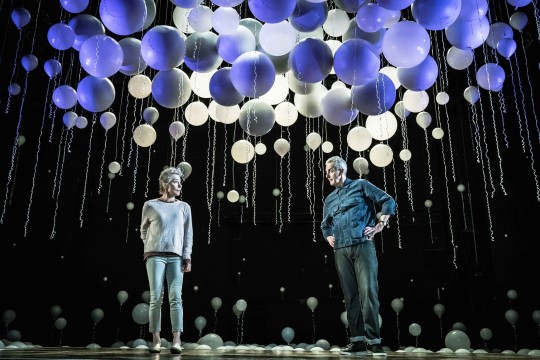
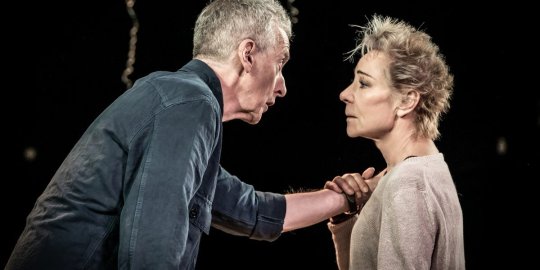



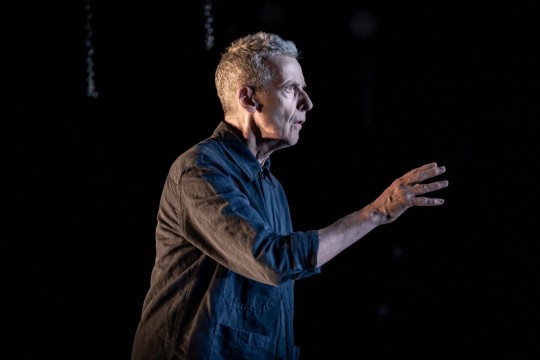
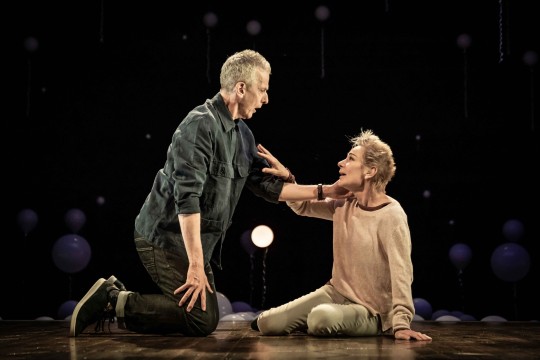
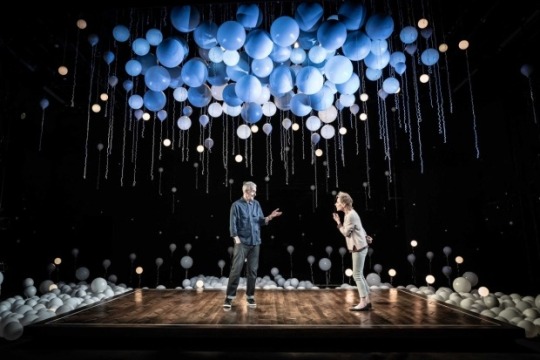
Constellations, Donmar Warehouse
Cast 2. Peter Capaldi, Zoe Wanamaker
Dir. Michael Longhurst
Written by. Nick Payne
175 notes
·
View notes